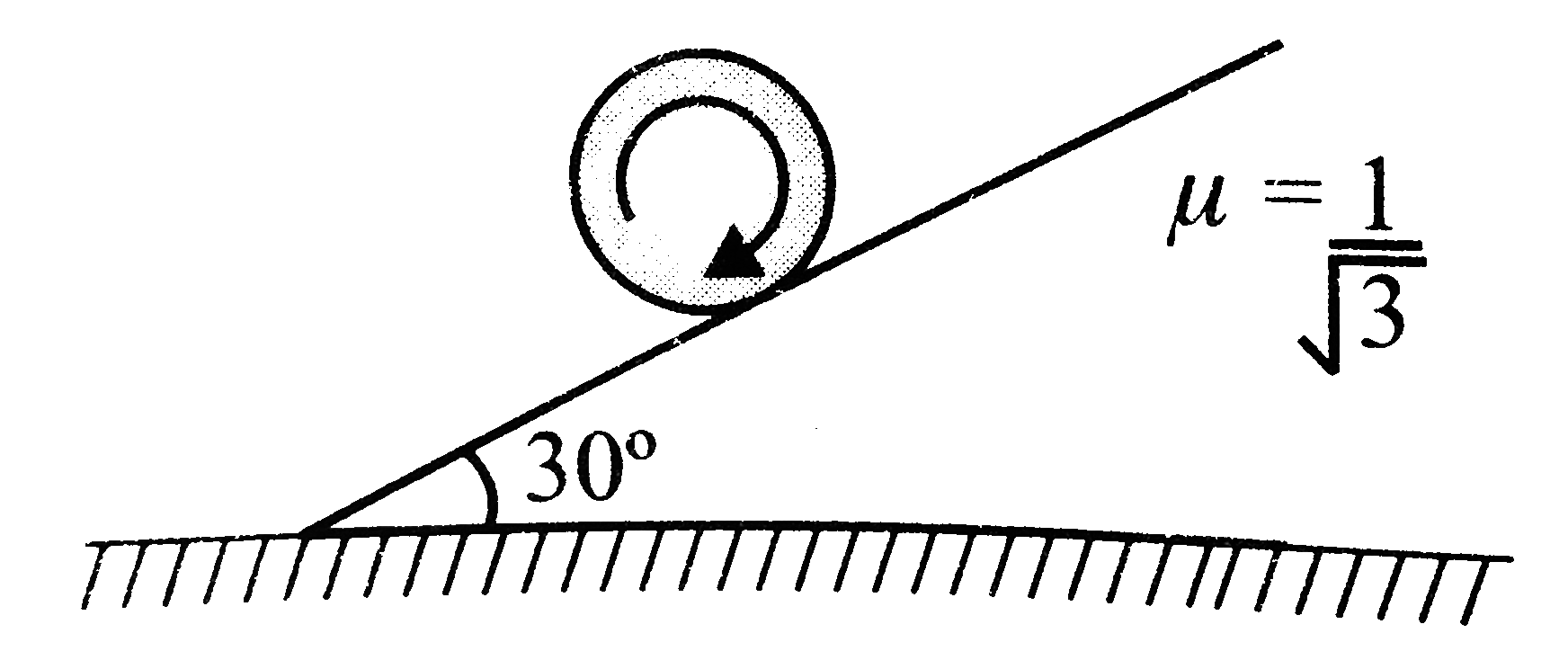The diameter of a solid disc is 0.5 m and its mass is 16 kg. What torque will increase its angular velocity from zero to 120 rotations/minute in 8 seconds.
To solve the problem step by step, we will follow these calculations:
Step 1: Identify the given values
- Diameter of the disc, d=0.5m
- Mass of the disc, m=16kg
- Final angular velocity, ωf=120rotations/minute
- Time, t=8s
Step 2: Convert the final angular velocity from rotations per minute to radians per second
To convert from rotations per minute (rpm) to radians per second, we use the conversion factor:
ωf=120rpm×2πradians1rotation×1minute60seconds
Calculating this gives:
ωf=120×2π60=4πrad/s
Step 3: Calculate the radius of the disc
The radius r is half of the diameter:
r=d2=0.52=0.25m
Step 4: Calculate the moment of inertia I of the solid disc
The moment of inertia I for a solid disc is given by the formula:
I=12mr2
Substituting the values:
I=12×16kg×(0.25m)2=12×16×0.0625=0.5kg m2
Step 5: Calculate the final angular momentum Lf
The final angular momentum Lf is given by:
Lf=Iωf
Substituting the values:
Lf=0.5kg m2×4πrad/s=2πkg m2/s
Step 6: Calculate the initial angular momentum Li
Since the initial angular velocity ωi=0:
Li=Iωi=0kg m2/s
Step 7: Calculate the torque τ
Torque τ is defined as the change in angular momentum over time:
τ=Lf−Lit
Substituting the values:
τ=2π−08=2π8=π4N m
Final Answer
The torque required to increase the angular velocity from zero to 120 rotations per minute in 8 seconds is:
π4N m
- Diameter of the disc, d=0.5m
- Mass of the disc, m=16kg
- Final angular velocity, ωf=120rotations/minute
- Time, t=8s
To convert from rotations per minute (rpm) to radians per second, we use the conversion factor:
ωf=120rpm×2πradians1rotation×1minute60seconds
Calculating this gives:
ωf=120×2π60=4πrad/s
The radius r is half of the diameter:
r=d2=0.52=0.25m
The moment of inertia I for a solid disc is given by the formula:
I=12mr2
Substituting the values:
I=12×16kg×(0.25m)2=12×16×0.0625=0.5kg m2
The final angular momentum Lf is given by:
Lf=Iωf
Substituting the values:
Lf=0.5kg m2×4πrad/s=2πkg m2/s
Since the initial angular velocity ωi=0:
Li=Iωi=0kg m2/s
Torque τ is defined as the change in angular momentum over time:
τ=Lf−Lit
Substituting the values:
τ=2π−08=2π8=π4N m
The torque required to increase the angular velocity from zero to 120 rotations per minute in 8 seconds is:
π4N m
Topper's Solved these Questions
- BOOK - DC PANDEY ENGLISHCHAPTER - ROTATIONEXERCISE - Check point 9.120videos
ROTATION
- BOOK - DC PANDEY ENGLISHCHAPTER - ROTATIONEXERCISE - Check point 9.220videos
ROTATION
- BOOK - DC PANDEY ENGLISHCHAPTER - RAY OPTICSEXERCISE - Integer type q.14videos
RAY OPTICS
- BOOK - DC PANDEY ENGLISHCHAPTER - ROTATIONAL MECHANICSEXERCISE - Subjective Questions2videos
ROTATIONAL MECHANICS
Similar Questions
A grind-stone is in the form of a solid cylinder has a radius of 0.5 m and a mass 50 kg. What torque will bring it from rest to an angular velocity of 300 rev/min in 10 s ? What is the kinetic energy when it is rotating at 300 rev/min ?
View SolutionThe rotational kinetic energy of a disc is 450 J and its moment of inertia is 100 kg m2. What is its angular momentum ?
View SolutionA ring of radius 0.5 m and mass 10 kg is rotating about its diameter with angular velocity of 20rads−1. Its kinetic energy is
View SolutionA disc of mass 4.8 kg and radius 1 m is rolling on a horizontal surface without sliding with angular velocity of 600 rotations/min. What is the total kinetic energy of the disc ?
View SolutionA ring of mass m and radius R is being rotated about its axis with angular velocity o. If o increases then tension in ring
View SolutionLength of clocks second hands 0.1 m what is the order of its angular velocity in radian per/sec.
View SolutionThe initial angular velocity of a heavy flywheel rotating on its axis is w0. Its angular velocity decreases due to friction. At the end of the first minute its angular velocity is 0.8ω0. What is its angular velocity at the end of third minute, if the frictional force is constant ?
View SolutionA solid sphere of radius r and mass m rotates about an axis passing through its centre with angular velocity ω. Its K.E. Is
View SolutionA flywheel is in the form of a uniform circular disc of radius 1m and mass 2kg. The work which must be done on it to increase its frequency of rotation from 5 to 10rev/s is approximately
View SolutionA disc is rotated about its axis with a certain angular velocity and lowered gently on a rough inclined plane as shown in Fig., then
 View Solution
View Solution

